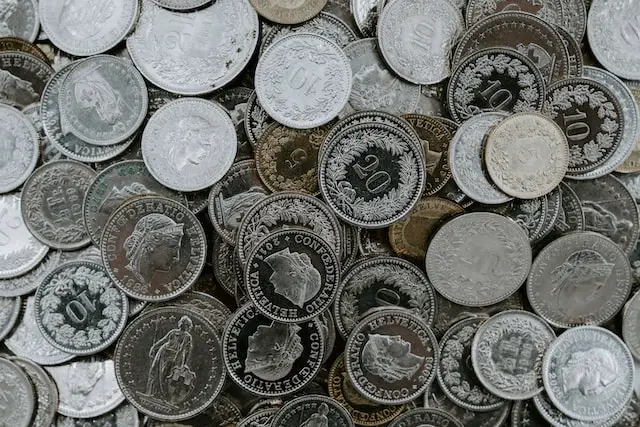In the vast world of numismatics, where collectors and enthusiasts delve into the rich history and exquisite craftsmanship of coins, certain specimens stand out not only for their historical significance but also for their astonishing value. Quarters, those familiar coins we often overlook in our everyday transactions, can sometimes hold hidden treasures.
In this article, we embark on a captivating exploration into the realm of the rare and valuable, as we unveil the ten most expensive quarters ever to grace the numismatic stage. From rare minting errors to coins steeped in fascinating tales, join us on this remarkable journey as we reveal the extraordinary worth and allure of these remarkable pieces of monetary history.
| No | Most Expensive Quarter | Price |
| 1 | 1796 Draped Bust Quarter | $1,740,000 |
| 2 | 1827/3/2 Proof Capped Bust Quarter | $705,000 |
| 3 | 1807 Draped Bust Quarter | $630,000 |
| 4 | 1901 S Barber Quarter | $550,000 |
| 5 | 1839 Proof Liberty Seated Quarter without Drapery |
$517,000
|
| 6 | 1873 CC Liberty Seated Quarter without Arrows |
$470,000
|
| 7 | 1850 Proof Liberty Seated Quarter | $460,000 |
| 8 | 1805 Draped Bust Quarter | $402,500 |
| 9 | 1823/2 Proof Capped Bust Quarter | $396,562.50 |
| 10 | 1838 Proof Liberty Seated Quarter without Drapery | $381,875 |
1796 Draped Bust Quarter
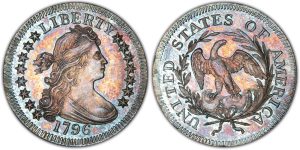
1796 Draped Bust Quarter is the most expensive quarter in the world. The 1796 Draped Bust Quarter is an esteemed and coveted coin among numismatic enthusiasts, revered for its historical significance and scarcity. Struck during the early years of American coinage, this quarter holds a special place in the hearts of collectors.
Designed by Robert Scot, the obverse of the coin features a graceful portrayal of Liberty, her hair draped elegantly. On the reverse, an intricately detailed heraldic eagle symbolizes the fledgling nation.
With its captivating design and limited mintage, the 1796 Draped Bust Quarter stands as a testament to the rich heritage of American numismatics. Its rarity and desirability contribute to its exceptional value, making it a prized possession for those who appreciate the artistry and history encapsulated within its small yet significant form.
1827/3/2 Proof Capped Bust Quarter
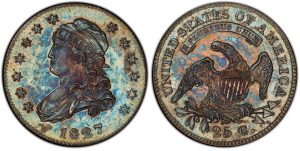
1827/3/2 Proof Capped Bust Quarter is the 2nd most expensive quarter in the world. The 1827/3/2 Proof Capped Bust Quarter is a remarkable and sought-after coin that holds a significant place in the realm of numismatic treasures. This particular quarter stands out for its unique and fascinating overdate feature, where the digits “1827” were originally impressed over a previous “1823” date, resulting in an intriguing layered appearance.
Struck during the era of the Capped Bust design, this coin showcases the elegant and dignified portrayal of Liberty on the Obverse, adorned with a cap and a charming drapery. The reverse side boasts an intricately detailed eagle, symbolizing strength and resilience. As a proof coin, it was produced with exceptional craftsmanship and precision, intended as a specimen of the highest quality.
The rarity and historical significance of the 1827/3/2 Proof Capped Bust Quarter contribute to its desirability and substantial value, capturing the imagination of collectors and numismatic enthusiasts alike.
1807 Draped Bust Quarter
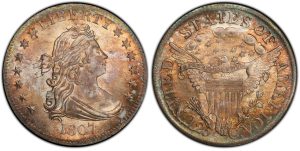
The 1807 Draped Bust Quarter is the 3rd most expensive quarter in the world. The 1807 Draped Bust Quarter holds a prominent place in American numismatic history, captivating collectors with its elegance and historical significance. Designed by Robert Scot, this coin features a distinguished depiction of Liberty on the obverse, her bust draped in a flowing garment.
The reverse showcases a majestic eagle perched upon a heraldic shield, symbolizing the young nation’s strength and unity. As one of the early quarters minted in the United States, the 1807 Draped Bust Quarter carries a sense of nostalgia and heritage. Its scarcity and age contribute to its allure, making it a highly sought-after piece among numismatic enthusiasts.
Whether appreciated for its artistry, historical value, or rarity, the 1807 Draped Bust Quarter serves as a tangible connection to the early days of American coinage and continues to inspire admiration and fascination today.
1901 S Barber Quarter
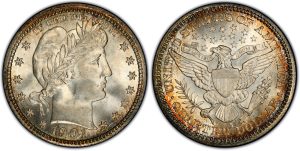
1901 S Barber Quarter is the 4th most expensive quarter in the world. The 1901 S Barber Quarter stands as a numismatic gem within the realm of American coinage, renowned for its exquisite design and historical significance. Designed by Charles E. Barber, the obverse of the coin features Lady Liberty donning a Phrygian cap, while the reverse showcases an intricately detailed eagle with outstretched wings perched on a bundle of arrows and an olive branch.
What sets the 1901 S Barber Quarter apart is its mintmark “S,” denoting its production at the San Francisco Mint. This mintmark adds a touch of exclusivity and scarcity to the coin, as the San Francisco Mint struck fewer quarters compared to its counterparts during that era. The 1901 S Barber Quarter captures the essence of a bygone era, serving as a tangible piece of American history that is highly sought-after by collectors and enthusiasts for its artistic beauty and rarity.
1839 Proof Liberty Seated Quarter without Drapery
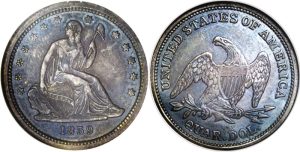
1839 Proof Liberty Seated Quarter without Drapery is the 5th most expensive quarter in the world. The 1839 Proof Liberty Seated Quarter without Drapery is an extraordinary coin that holds both historical and numismatic significance. Designed by Christian Gobrecht, this coin features the iconic Liberty Seated design on the Obverse, showcasing Liberty seated on a rock, holding a shield in one hand and a liberty pole with a Phrygian cap in the other.
What sets the 1839 Proof Liberty Seated Quarter without Drapery apart is the absence of drapery on Liberty’s left arm, a distinctive feature that was later added in subsequent years. As a proof coin, it was struck with exceptional craftsmanship and attention to detail, intended as a specimen of the highest quality.
The scarcity and unique variation of the 1839 Proof Liberty Seated Quarter without Drapery makes it highly sought-after among collectors, reflecting a fascinating era in American numismatic history and representing a true treasure in the world of rare coins.
1873 CC Liberty Seated Quarter without Arrows

1873 CC Liberty Seated Quarter without Arrows is the 6th most expensive quarter in the world. The 1873 CC Liberty Seated Quarter without Arrows is a captivating and rare coin that holds a special place in the realm of American numismatics. Designed by Christian Gobrecht, this coin features the iconic Liberty Seated design on the Obverse, portraying Liberty seated on a rock, holding a shield in one hand and a liberty pole with a Phrygian cap in the other.
What distinguishes the 1873 CC Liberty Seated Quarter without Arrows is the absence of arrows on either side of the date, which were added in later years to indicate a reduction in the weight of the coin. Minted at the Carson City Mint, this coin carries additional historical significance as it bears the mark “CC,” denoting its production at this renowned western mint. The 1873 CC Liberty Seated Quarter without Arrows is highly prized among collectors due to its limited mintage, striking design, and intriguing absence of arrows, making it a cherished piece of American numismatic history.
1850 Proof Liberty Seated Quarter
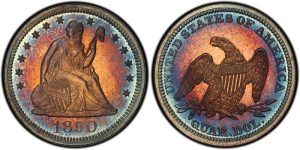
1850 Proof Liberty Seated Quarter is the 7th most expensive quarter in the world. The 1850 Proof Liberty Seated Quarter is a true numismatic treasure that embodies the elegance and craftsmanship of the mid-19th century. Designed by Christian Gobrecht, this coin features the iconic Liberty Seated design on the Obverse, depicting Liberty seated on a rock, holding a shield and liberty pole.
The reverse showcases an intricately detailed eagle with outstretched wings perched on a bundle of arrows and an olive branch. What distinguishes the 1850 Proof Liberty Seated Quarter is its proof designation, denoting that it was struck with exceptional care and precision. As a proof coin, it exhibits sharp details, mirror-like surfaces, and a high level of artistry.
The 1850 Proof Liberty Seated Quarter is scarce, as only a limited number of these coins were produced for collectors and dignitaries of the time. Its rarity, combined with its historical significance and captivating design, make the 1850 Proof Liberty Seated Quarter a highly sought-after piece among collectors, representing a tangible piece of American numismatic history that continues to inspire awe and admiration.
1805 Draped Bust Quarter
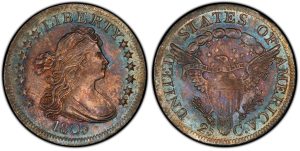
1805 Draped Bust Quarter is the 8th most expensive quarter in the world. The 1805 Draped Bust Quarter is a remarkable coin that holds a special place in American numismatic history. Designed by Robert Scot, this coin features a captivating portrayal of Liberty on the Obverse, her bust draped in flowing fabric. The reverse showcases an intricately designed heraldic eagle, symbolizing the strength and freedom of the young United States.
Minted during a time of great significance, the 1805 Draped Bust Quarter represents a pivotal era in American history. With its classic design and historical significance, this coin captures the essence of early American coinage and serves as a tangible connection to the nation’s past. The 1805 Draped Bust Quarter is highly coveted by collectors for its rarity and aesthetic appeal, making it a prized addition to any numismatic collection.
1823/2 Proof Capped Bust Quarter
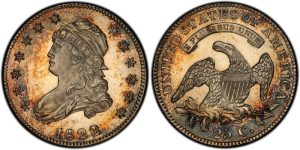
1823/2 Proof Capped Bust Quarter is the 9th most expensive quarter in the world. The 1823/2 Proof Capped Bust Quarter is a captivating and highly sought-after coin that holds a significant place in the world of numismatics. This quarter stands out due to its unique overdate feature, where the digits “1823” were initially struck over a previous “1822” date, resulting in a fascinating layered appearance.
Designed by John Reich, the obverse of the coin showcases the elegant and dignified portrayal of Liberty, her bust adorned with a cap and a flowing drapery. The reverse side features an intricately detailed eagle perched upon a shield, representing the strength and unity of the young United States.
As a proof coin, it was struck with exceptional craftsmanship and precision, intended as a specimen of the highest quality. The 1823/2 Proof Capped Bust Quarter is not only esteemed for its rarity but also admired for its historical significance and artistic beauty, making it a prized possession among collectors and numismatic enthusiasts alike.
1838 Proof Liberty Seated Quarter without Drapery
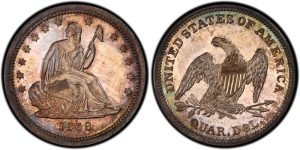
1838 Proof Liberty Seated Quarter without Drapery is the 10th most expensive quarter in the world. The 1838 Proof Liberty Seated Quarter without Drapery is a remarkable and significant coin that holds a prominent place in American numismatic history. Designed by Christian Gobrecht, this coin showcases the iconic Liberty Seated design on the Obverse, featuring Liberty seated on a rock, holding a shield and a liberty pole with a Phrygian cap.
What sets the 1838 Proof Liberty Seated Quarter without Drapery apart is the absence of the customary drapery on Liberty’s left arm, making it a unique variation of this design. As a proof coin, it was struck with exceptional precision and craftsmanship, intended as a specimen of the highest quality.
The scarcity of the 1838 Proof Liberty Seated Quarter without Drapery, combined with its distinctive feature and historical significance, makes it highly sought-after among collectors and numismatic enthusiasts. It represents a tangible piece of American history and serves as a testament to the artistry and evolution of American coinage during this era.
Frequently Asked Questions
How much does a quarter weigh?
A standard quarter minted in the United States weighs approximately 5.67 grams or 0.2 ounces. This weight is based on the composition of the quarter, which is primarily a combination of copper and nickel. It’s worth noting that the weight of a quarter may vary slightly due to manufacturing tolerances and wear over time.
How much is a silver quarter worth?
The value of a silver quarter depends on several factors, including its date, condition, and silver content. Quarters minted in the United States before 1965 were made of 90% silver and 10% copper. These silver quarters, commonly referred to as “junk silver,” have a certain intrinsic value based on the current market price of silver.
The approximate silver value of a pre-1965 silver quarter is around its face value multiplied by the silver content. Considering a face value of $0.25, the silver content in such a quarter is roughly 0.1808 troy ounces (or 5.615 grams). To calculate the silver value, you would multiply the silver content by the current market price of silver per ounce or gram.
Please note that silver prices fluctuate constantly due to market conditions, so it is essential to check the current market rates to determine the precise value of a silver quarter. Additionally, if a silver quarter has numismatic or collector’s value beyond its silver content, its worth may differ significantly from its melt value.
How much is a quarter?
The value of a quarter can vary depending on the specific context. Here are a few different interpretations of the value of a quarter:
1. Face Value: In terms of currency, a quarter typically has a face value of 25 cents in the United States. It is one-fourth, or 1/4, of a U.S. dollar.
2. Numismatic Value: Some quarters may have value to collectors beyond their face value. Coins with unique features, errors, or historical significance can be sought after by collectors, and their value may exceed their face value. The specific value would depend on factors such as rarity, condition, and demand in the collector’s market.
3. Exchange Value: In certain countries, the term “quarter” can refer to a unit of currency worth one-fourth of the main currency. For example, in Canada, a quarter refers to a 25-cent coin.
It’s worth noting that currency values can change over time, and the value of a quarter may be subject to factors such as inflation, currency exchange rates, and collector demand.
How much is a 1965 quarter worth?
A 1965 quarter, commonly known as a “clad” quarter, has a face value of 25 cents in the United States. These quarters are composed of a copper-nickel alloy and do not contain any silver. In terms of its intrinsic metal value, a 1965 quarter does not have a significant worth beyond its face value.
However, it’s important to note that coins can have numismatic value depending on their condition, rarity, and demand among collectors. In the case of a 1965 quarter, since it is a relatively common coin with a large mintage, its numismatic value is typically not substantial unless it is in exceptional condition or part of a specific set or variety that is highly sought after by collectors.
If you believe your 1965 quarter might have numismatic value, it is recommended to consult with a reputable coin dealer or expert who can assess its condition and rarity to provide a more accurate valuation.
What year of quarters are worth the money?
Several years of quarters can be worth a significant amount of money, typically due to their rarity, condition, or specific varieties. Here are some examples of quarters that are often sought after by collectors and can have higher values:
1. Early Quarters: Quarters minted in the early years of the United States, such as the Draped Bust Quarters (1796-1807) and Capped Bust Quarters (1815-1838), can have higher values due to their age and historical significance.
2. Key Date Quarters: Certain years within a coin series may have lower mintages or are considered more difficult to find in higher grades. These key date quarters can include coins such as the 1932-D and 1932-S Washington Quarters, which were the first years of the series, and the 1950-D Washington Quarter.
3. Silver Quarters: Quarters minted before 1965 contain 90% silver and have a higher intrinsic value due to the silver content. These “junk silver” quarters can be worth more than their face value based on the current market price of silver.
4. Error or Variety Quarters: Quarters with unique errors or varieties can also have higher values. Examples include the 1970-S Washington Quarter with a small “S” mintmark and the 2004-D Wisconsin Quarter with an extra leaf.
It’s important to note that the value of these quarters can vary greatly depending on factors such as condition, rarity, and demand within the collector’s market.
Why is a 1965 quarter valuable?
A 1965 quarter is not typically considered valuable in terms of its numismatic or collector’s value. This is because 1965 quarters, along with quarters minted from 1965 to 1967, were made of a copper-nickel-clad composition, rather than containing any silver. These quarters do not have any significant intrinsic value beyond their face value.
However, it’s important to note that there can be exceptions or specific circumstances that make a 1965 quarter valuable. For instance:
1. Mint Errors: If a 1965 quarter has a notable mint error, such as a double die or a striking error, it could potentially have a numismatic value beyond its face value.
2. High Grade or Proof Coins: If a 1965 quarter is in exceptionally high grade or is a proof coin (special coins struck for collectors), it could hold some additional value to collectors due to its condition and rarity.
3. Varieties or Specific Markings: Some quarters may have specific varieties or markings that are rare or sought after by collectors. It’s worth researching and consulting with experts or reference materials to determine if your 1965 quarter falls into any such category.
It’s important to have any potentially valuable coin authenticated and appraised by reputable coin experts or numismatic professionals to determine its true worth.
Why is the 1970 quarter rare?
The 1970 quarter is considered rare because, officially, no quarters were minted with a 1970 date. The United States Mint did not produce any quarters with a 1970 date for circulation or general release. The reason behind this rarity is attributed to a series of circumstances and decisions made by the Mint.
In 1970, the Mint had planned to transition from using silver in the production of quarters to a copper-nickel-clad composition. However, due to delays in the production of the new clad quarters, the Mint continued to strike 1969-dated quarters into early 1970. These 1969-dated quarters were produced at three different mint facilities: Philadelphia, Denver, and San Francisco.
However, some examples of the 1970 quarter were mistakenly struck at the San Francisco Mint using 1968-dated proof dies. These quarters bore the “S” mintmark but were mistakenly struck with the previous year’s date. The error was discovered, and most of the erroneous 1970-dated quarters were destroyed. However, a few of these rare 1970-S quarters managed to escape destruction, making them highly sought after by collectors.
As a result, the 1970-S quarter is considered a rarity among U.S. coins, and examples in any condition command a premium value due to their scarcity and desirability among collectors.

